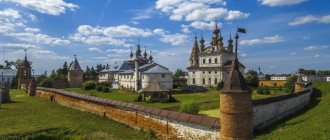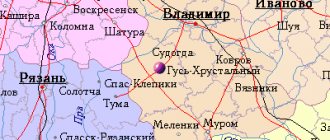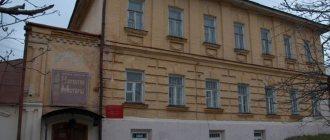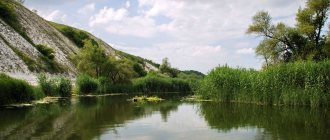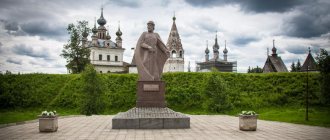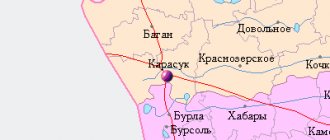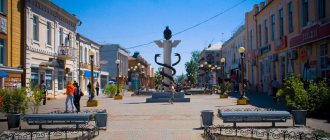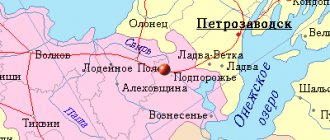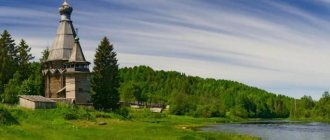For other uses, see Yuryev-Polsky.
City in Vladimir region, Russia
| Yuriev-Polsky Yuriev-Polsky | |
| City [1] | |
| View of Yuryev-Polsky | |
| Flag Coat of arms | |
| Location Yuryev-Polsky | |
| Yuriev-Polsky Location Yuryev-Polsky Show map of Russia Yuriev-Polsky Yuryev-Polsky (Vladimir region) Show map of Vladimir region | |
| Coordinates: 56°30'N 39°41'E / 56.500°N Latitude 39.683°E / 56,500; 39.683 Coordinates: 56°30'N 39°41'E. / 56.500 ° N Latitude 39.683°E / 56,500; 39,683 | |
| A country | Russia |
| Federal subject | Vladimir region [1] |
| Administrative region | Yuryev-Polsky district [1] |
| Based | 1152 |
| Height | 140 m (460 ft) |
| population size (2010 Census) [2] | |
| • General | 19 595 |
| • Evaluate (2018) [3] | 18 433 ( -5,9% ) |
| Administrative status | |
| • Capital from | Yuryev-Polsky district [4] |
| Municipal status | |
| • Municipal district | Yuryev-Polsky municipal district [5] |
| • Urban village | Yuryev-Polsky urban settlement [5] |
| • Capital from | Yuryev-Polsky municipal district [5], urban settlement Yuryev-Polsky [5] |
| Timezone | UTC+3 (MSK[6]) |
| Postal code [7] | 601800 |
| Dialing code(s) | +7 49246 |
| OKTMO ID | 17656101001 |
Yuryev-Polsky
(Russian: Yuryev-Polsky) is an old town and administrative center in the Yuryev-Polsky District of Vladimir Oblast, Russia, located in the upper reaches of the Koloksha River, 68 km (42 mi) northwest of Vladimir, then the administrative center of the region. Population: 19,595 (2010 census); [2] 19,906 (2002 census); [8] 22,247 (1989 census); [9] 23000 (1974).
History[edit]
It was founded by Yuri Dolgoruky in 1152. [ Edit
] The first part of its name comes from the patron saint of Yuri - St. George the Victorious.
The second part is derived from a Polish
meaning "in the fields". This specification was necessary to distinguish the city from the previously established fortress of Yuryev (now Tartu), then located in a forest in what is now Estonia, and then the largest Russian settlement in the territory of Chudei.
After the death of Vsevolod III in 1212, the city was transferred to one of his younger sons, Svyatoslav. It was this prince who personally designed the main landmark of the city - the Cathedral of St. George (1230–1234). This is the newest pre-Mongol building in Russia, unprecedented in the abundance of stone sculptures, as well as a model of the first stone churches of the Moscow Kremlin. In the 1460s, the cathedral's dome collapsed, burying most of the unique sculptures that adorned the walls of the cathedral. The collapsed roof was carelessly restored by the famous Moscow artisan Vasily Ermolin in 1471.
St. George's Cathedral (1230-1234) was the last stone temple built in Rus' before the Mongol invasion.
In 1216, the great battle of Lipica took place near the city. In 1238, Yuryev was sacked by the Mongols. A century later it was incorporated into the Grand Duchy of Moscow. The main monument of the Muscovite period is the walled monastery of the Archangel Michael, founded in the 13th century and containing various buildings from the 17th and 18th centuries. A few kilometers from Yuryev, on the banks of the Yakhroma River, stands the Kosminsky Monastery, the buildings of which are typical of the mid-17th century.
Yuryev-Polsky Cathedral.
The cathedral, which is small in size and ends with one chapter, seems monumental due to the vestibules protruding from three sides. The walls are decorated from top to bottom with carvings depicting animals, birds, trees, etc., and therefore the building seems to be covered with lace. The best preserved are the northern wall and part of the western one. From them one can judge the fabulous beauty of the temple before its destruction.
Links[edit]
Notes[edit]
- ^ abcd Resolution No. 433
- ^ a b Federal State Statistics Service (2011). “All-Russian Population Census 2010. Volume 1" [All-Russian Population Census 2010, vol. 1]. All-Russian Population Census 2010 [All-Russian Population Census 2010]
. Federal State Statistics Service. - "26. The size of the permanent population of the Russian Federation by municipalities as of January 1, 2022". Federal State Statistics Service. Retrieved January 23, 2022.
- ^ ab State Committee of the Russian Federation on Statistics. Committee of the Russian Federation for Standardization, Metrology and Certification. No. OK 019-95 January 1, 1997 “All-Russian classifier of objects of administrative-territorial division. Code 17 256", ed. changes No. 278 / 2015 dated January 1, 2016. (Goskomstat of the Russian Federation. Committee of the Russian Federation for Standardization, Metrology and Certification. No. OK 019-95 January 1, 1997. Russian classification of administrative divisions) (OKATO).
Code 17 256 , as amended by Amendment No. 278/2015 of January 1, 2016). - ^ abcde Law No. 55-OZ
- "On the Calculation of Time". Official Internet portal of legal information
. June 3, 2011. Retrieved January 19, 2022. - Post office. Information and computing center of OASU RPO. ( Post office
).
Search for postal service objects ( postal Search for objects
) (in Russian) - ↑
Federal State Statistics Service of Russia (May 21, 2004).
“The population of Russia, the constituent entities of the Russian Federation as part of federal districts, urban settlements, settlements, settlements is 3 thousand or more people” [Population of Russia, its federal districts, federal districts, districts Urban settlements, rural settlements - administrative centers and rural settlements with a population of over 3,000] (XLS). All-Russian Population Census 2002
. - “All-Union Population Census of 1989. The current population of union and autonomous republics, autonomous regions and districts, territories, negative phenomena, urban settlements and rural district centers” [All-Union Population Census of 1989: current population of union and autonomous republics, Autonomous regions and districts , territories, regions, districts, towns and villages performing the functions of district administrative centers. All-Union Population Census of 1989 [All-Union Population Census of 1989]
.
Institute of Demography of the National Research University: Higher School of Economics [Institute of Demography of the National Research University: Higher School of Economics]. 1989 - via Demoscope Weekly
.
Sources [edit]
- Administration of the Vladimir region. Resolution No. 433 of June 13, 2007 “On the register of administrative-territorial entities and units of the Vladimir region,” as amended. Resolution No. 169 of March 5, 2015 “On amendments to the Resolution of the Regional Governor dated June 13, 2007 No. 433 “On the register of administrative-territorial entities and units of the Vladimir Region””. Came into force on the date of official publication. Published: “Vladimirskie Vedomosti”, No. 114, June 20, 2007 (Administration of the Vladimir Region. Resolution No. 433 of June 13, 2007 “ On the register of administrative-territorial formations and units of the Vladimir Region”
as amended by Resolution No. 169 of March 5, 2015 On
amendments to the decree of the Governor of the region dated June 13, 2007 No. 433 “On the register of administrative-territorial entities and units of the Vladimir region"
. Valid from the date of official publication.). - Legislative Assembly of the Vladimir Region. Law No. 55-OZ of May 11, 2005 “On endowing the Yuryev-Polsky district and the newly formed municipalities included in its composition with the status of municipalities and their borders,” as amended. Law No. 54-OZ of June 14, 2012 “On amendments to Appendix 8-1 to the Law of the Vladimir Region” On granting the Yuryev-Polsky district and the newly formed municipalities included in its composition the status of municipalities and establishing their boundaries "". Came into force on the date of official publication (May 17, 2005). Published: “Vladimirskie Vedomosti”, No. 156–157, May 17, 2005 (Legislative Assembly of the Vladimir Region. Law No. 55-OZ of May 11, 2005 On assigning the Yuryev-Polsky district and newly formed municipalities the corresponding status of municipalities and on establishing their boundaries
as amended by the Law of June 14, 2012 No. 54-OZ “
On amendments to Appendix 8-1 of the Law” of the Vladimir region “On giving the Yuryev-Polsky district and newly created municipalities the corresponding status of municipalities and on establishing them borders"
. Valid from the date of official publication (May 17, 2005).
YURIEV-POLSKY
YURYEV-POLSKY, a city in Russia, in the Vladimir region, the center of the Yuryev-Polsky municipal district. Population 18.1 thousand people. (2019). Located on the river. Koloksha. Railway station. Road junction.
Story
Photo by A. I. Nagaev Yuriev-Polsky. Panorama of the city center (on the left - St. George and Trinity Cathedrals; on the right - St. Michael the Archangel Monastery).
Founded no later than 1151 by the Rostov-Suzdal prince. Yuri Vladimirovich Dolgoruky in the Suzdal region (hence the name - Polsky, Polish). The ring fort (area approx. 9.5 hectares), surrounded by a rampart (height 4–6 m, length approx. 1 km) and a ditch, is located on the left bank of the river. Koloksha at the confluence of the river. Gza. Among the finds are iron cylinders. locks and keys to them, glass bracelets, rings, beads, fragments of glass goblets, parts of horos (including brackets for candles in the form of dragons), remains of households. buildings (12th–13th centuries), fragments of Black Sea amphorae. Under Yuri Dolgoruky, St. George's Cathedral was built on the site (in 1230–34 a new St. George's Cathedral was erected). First mentioned as Yuriev in 1176. In 1212 - mid. 14th century center of the Yuryev Principality. In 1238 it was captured during the Mongol-Tatar invasion, destroyed in 1293 during the so-called. "Dyuden's army", later - during Tokhtamysh's raid of 1382 and Edigei's raid of 1408. In the 16th century. led princes of Moscow and Russia. kings complained about feeding the serving Tatars: in 1508–12 former. Kazan Khan Abd al-Latif, in 1552–70 - Astrakhan prince Abdullah bin Ak-Kubek (Kaibul). In 1609, False Dmitry II gave Yu.-P. to feed the Kasimov prince Muhammad Murat, who lost his rights as a result of the uprising of the inhabitants. In 1612 it was devastated by Polish-Lithuanian troops during the intervention of the Polish-Lithuanian Commonwealth in the early 17th century. From ser. 17th century large shopping center. District (from 1708) and provincial (from 1719) city of the Moscow province (1708–1778), district city of the Vladimir province (1778–1925; until 1796 – Vladimir governorship). In the 18th–19th centuries. an important center for paper weaving and flax weaving production. Railway traffic is open. lines Belkovo - Yuryev-Polsky (1898), Yuryev-Polsky - Teykovo (1899). Sov. power was established on October 28 (November 10), 1917. District town of Ivanovo-Voznesensk province (1925–29). Regional center of the Ivanovo Industrial Region (1929–36), Ivanovo Region (1936–44), Vladimir Region (since 1944). In 2004–2005 it formed a city district, since 2005 the center of the municipal district.
Architecture. Cultural centers
The city received a regular layout according to the general plan of 1788. On the territory of the fort, along with St. George's Cathedral, there are: the office building. places (1809), Trinity Cathedral in Russian style (1907–14; chapters lost), St. Michael the Archangel Monastery. (13th century, restored in the 15th–16th centuries, closed in the 1920s) with a 5-domed cathedral (1792–1806), a hipped bell tower (1680s), a refectory with a church. in honor of the icon of the Mother of God “The Sign” (1625), the Holy Gates (1653) with a gateway c. Ap. John the Evangelist (1670), wood. c. St. George the Victorious (1718, moved from the former St. George Monastery in 1967–68), the archimandrite building (1763) and walls with towers (previously 1736).
In the center there are also preserved: St. Vvedensky Nikon's men's monastery. (founded no later than the mid-17th century as a women's monastery, transferred to the former Peter and Paul Monastery in 1874, restored in 2001 as a men's monastery; St. Nikon of Radonezh Church, 1666; Vvedenskaya Church, 1763–66), c. Resurrection of Christ (mid-18th century, rebuilt in the 19th century and 1930s), the ensemble of churches of the Intercession of the Blessed Virgin Mary (1769) and the Great Martyr. Nikita (1796; in the style of classicism) and bell towers (19th century), the building of the Noble Assembly (1870), shopping arcades (1873–77), brick and wood. at home 19 – beginning 20th centuries All in. parts of the city - the Church of the Nativity (18th century), the Ascension of the Lord (1780), former. Petropavlovsk men's monastery (founded in the 16th–17th centuries, abolished in 1764, revived as a women's church in 1874, closed in the 1920s) with the ruins of a cathedral in the Russian-Byzantine style (1843–53) and a bell tower (1898–1902). Monument to the book Yuri Dolgoruky (2002, sculptor I. A. Chernoglazov). Historical-architect. and artist museum (1920).
In the vicinity of South-Petersburg, in the village. Unprecedented, - Holy Dormition Cosmin male mon. (founded no later than the 3rd quarter of the 15th century, closed in 1923, revived in 1996) with the Assumption Cathedral (1657), c. Savior Not Made by Hands (between 1666 and 1675), a 2-story cell building (1669), a gatehouse. St. Nicholas the Wonderworker (1690).
Farm
There are: the Promsvyaz plant (power supply equipment, heating cabinets, etc.), the Avangard weaving and finishing factory (furniture and decorative, terry cotton and other fabrics, garments for the home), food industry enterprises (meat processing plant, etc. .).
Yuriev-Polsky St. George's Cathedral.
In 1471, the famous Russian architect Vasily Ermolin was assigned to restore the temple. When erecting a new cathedral building, the architect was unable to assemble the multi-figure composition into a single whole, and some of the stones were used for laying the vaults and for the construction of buildings built nearby. Already in the 20th century. the famous restorer P. D. Baranovsky collected some of these stones and kept them inside the temple. Many researchers have been deciphering the “stone rebus”, trying to reveal the original appearance of this temple. The most successful were the works of researchers of Russian architecture N.N., Voronin and G.K. Wagner.
Yuryev-Polsky attractions.
In 1625, the Znamenskaya Refectory Church was erected. It has two floors: the lower one was used for economic purposes, and on the upper floor there was a square hall of the refectory, connected to the church. In 1654-1670. The gate church of St. John the Evangelist was erected with two gated entrances and two entrances. On the second floor of the building there is a porch with arched windows. The five-domed temple is built of brick and richly decorated.
Yuryev-Polsky Trinity Cathedral.
The youngest religious building in the city is the Trinity Cathedral, erected at the beginning of the 20th century. This is one of the most elegant buildings in the city. In Yuryev-Polsky, wooden residential buildings from the 19th century have been preserved, which give an idea of the Russian pre-revolutionary province and are of great architectural and historical significance. The study and restoration of surviving monuments of Russian architecture began in our country only in the 20th century. Especially a lot was done after the Great Patriotic War and in the 1960s.
St. George's Cathedral.
St. George's Cathedral is perhaps the last stone structure of the pre-Mongol period on the Vladimir-Suzdal land. All the innovative solutions of white stone architecture by local craftsmen found expression in it. The system of sculptural decoration, closely connected with the architectural appearance, “expressed a pre-thought-out plan - the idea of the grandeur and beauty of the universe, compared with the power and prosperity of the Vladimir-Suzdal land led by its princes” - this is how G. K. Wagner spoke about the temple. Even in the form that has come down to us, modified by perestroika, St. George's Cathedral remains the unsurpassed pinnacle of great ancient Russian art, an example of a wonderful synthesis of architecture and sculpture.
